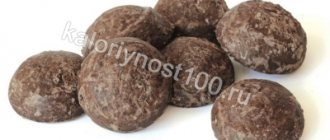Calorie intake per day
As such, there is no single and generally accepted daily calorie intake. According to the recommendations of the World Health Organization, “energy entering the body (in calories) must be balanced with energy expended.” Thus, your individual calorie intake depends, first of all, on the nature of your work, level of physical activity, gender, age and a number of other factors. However, on the Internet you can find many tables and calculators of unknown origin, offering information on daily values, supposedly based on authoritative sources. We believe that the quality of this information is quite questionable.
The most reliable way to determine individual calorie needs is to simply calculate the energy value of food consumed during the day (or several days). Just record your normal daily diet on paper. Write down what and how much you ate during the day. Calorie content can be directly calculated using information from product labels and using our website. Provided that you are healthy and your weight does not change much with your current diet, the results obtained can be conditionally considered your daily norm.
To lose weight, you need to slightly reduce your daily energy intake. If you maintain your current lifestyle, you will experience a slight calorie deficit because your costs will remain the same. This will lead to the gradual burning of your fat reserves. What exactly the deficit should be is up to you to decide. We strongly advise against increasing it sharply, because... it won't lead to anything good. Reduce your calorie intake gradually and lose weight slowly. This way you won’t have to torture yourself and break down from time to time. And of course, before making any dietary changes, we strongly recommend that you consult with your doctor or qualified dietitian.
Citric acid - benefits and harms
Citric acid is found in half of all food products and has a wide range of beneficial properties, but can also negatively affect health. People who care about their health are interested in the benefits and harms of citric acid. This should be looked into in more detail.
Chemical properties of citric acid
The white matter can be classified as a natural or synthetic antioxidant. When heated above 175°C, it breaks down into water and carbon dioxide. Citric acid has a low level of toxicity, dissolves quickly and mixes well with other chemicals. It is worth noting that it is environmentally friendly. The composition of citric acid depends on the extraction method. It is found in citrus fruits, pine needles, berries, shag stems, etc. But today it is not profitable to obtain acid from fruits. Therefore, it is synthesized from sugar-containing products (sugar, sugar beets, molasses, sugar cane) by fermentation in the culture liquid of certain fungi of the genus Aspergillus and Penicillium.
What are the benefits of citric acid?
- In cooking, this substance is called food additive E330-E333. It gives products a sweetish taste and acts as an antioxidant. The substance is absolutely safe for health in moderate quantities. During production, it is added to mayonnaise, ketchup, sauces, canned food, various drinks, processed cheeses, jellies, confectionery, etc.
- Citric acid helps remove waste and toxins from the body. It has a beneficial effect on digestion, improves immunity and burns carbohydrates. It is produced exclusively in solid form, so it does not harm the mucous membranes.
- During a cold, citric acid relieves sore throat. It is necessary to prepare a 30% solution of citric acid and gargle with it every hour. Instead of dry citric acid, you can slowly suck lemon slices without the peel so that the juice gets to the walls of the throat.
- The positive properties of citric acid have been noted for hangover syndrome. In this case, it helps to quickly remove toxic substances from the poisoned body.
- The enormous benefits of this substance include renewing new cells, increasing skin elasticity and reducing deep wrinkles. Therefore, people with low stomach acidity are recommended to consume fruits containing this substance, but strictly according to doctor’s instructions.
- Citric acid tightens enlarged facial pores and has a whitening effect. To wipe your face you need to use a 2-3% solution of citric acid or lemon juice. After performing a series of regular procedures, the skin will become clean and acquire a pleasant matte tint.
- The substance is useful for the beauty of nails. It carefully cares for the plate, as a result of which the nails become smooth and shiny. But you shouldn’t apply this product too often. Experts recommend using it in courses.
Harm of citric acid
The human body already contains citric acid, so it must be consumed with caution and in accordance with the dosage. Solutions that are too saturated can cause skin irritation, especially in people with sensitive skin. Irritation of the mucous membranes of the stomach may also occur. It is important to remember that it is not advisable to inhale dry citric acid, so as not to provoke irritation of the respiratory tract.
Citric acid is a very valuable product, but it is useful in moderation. Therefore, it is not recommended to use it separately from food products. The only exception is the fruits that contain it.
What are the benefits of Lemon?
- Vitamin C
is involved in redox reactions, the functioning of the immune system, and promotes the absorption of iron. Deficiency leads to loose and bleeding gums, nosebleeds due to increased permeability and fragility of blood capillaries. - Copper
is part of enzymes that have redox activity and are involved in the metabolism of iron, stimulates the absorption of proteins and carbohydrates. Participates in the processes of providing oxygen to the tissues of the human body. Deficiency is manifested by disturbances in the formation of the cardiovascular system and skeleton, and the development of connective tissue dysplasia.
You can see a complete guide to the healthiest foods in the “My Healthy Diet” app.
- home
- Product composition
- Composition of fruits and berries
- Chemical composition of "Lemon"
Tags:
Lemon calorie content 34 kcal, chemical composition, nutritional value, vitamins, minerals, benefits of Lemon, calories, nutrients, beneficial properties of Lemon
Energy value, or calorie content
- this is the amount of energy released in the human body from food during the digestion process. The energy value of the product is measured in kilocalories (kcal) or kilojoules (kJ) per 100 grams. product. The kilocalorie used to measure the energy value of food is also called a food calorie, so when caloric content is reported in (kilo)calories, the prefix kilo is often omitted. You can see detailed energy value tables for Russian products here.
The nutritional value
— content of carbohydrates, fats and proteins in the product.
Nutritional value of food product
- a set of properties of a food product, in the presence of which the physiological needs of a person for the necessary substances and energy are satisfied.
How to dissolve correctly? Product price
Citric acid is a food product in powder form that is freely sold in all stores. It is packaged in packages of different sizes and can cost from 20 to 30 Russian rubles per 50 grams.
If a culinary recipe specifies this or that amount of citric acid, then before adding the powder to the dish, it is recommended to dissolve it. As a rule, ordinary drinking water is used for this. The resulting solution is added to cream, sauce or dough. By the way, in the case of the latter application, citric acid is used for a reason, but to extinguish table soda. If you dilute the powder substance correctly, you can get very fluffy, tasty and aromatic baked goods.
What is this substance and what is it made from?
Citric acid is a chemically produced powder. It is a tribasic carbonic organic compound. It looks like a scattering of small white crystals. It has a pronounced sour taste and no odor.
Let's find out what citric acid is made from:
- More than 200 years ago, it was first obtained by a Swedish pharmacist, isolating it from lemon juice and using calcium;
- Almost a hundred years later, English scientists learned to make a substance from calcium citrate. The juice of unripe lemons was combined with quicklime, and the resulting salts were crystallized. As a result, the desired powder was obtained, but in very small quantities. The method was expensive and labor-intensive, so people tried to figure out how to make citric acid differently;
- Towards the beginning of the 20th century, chemists discovered an enzymatic method for extracting a product from penicillin mushrooms. The substance was made from carbohydrate compounds, affecting them with mold fungi. The method was good, but extremely difficult in terms of purifying the final product;
- Surely you are interested in how citric acid is made today. The main production method is also biosynthesis; corn, sweet potatoes, cassava and even agricultural waste are used as raw materials. Cleaning is done with activated carbon.
We also recommend: What is Gazpacho
Citric acid is found in almost every living organism! Most of it is in citrus fruits, in berries - raspberries, cranberries, strawberries, black currants, tomatoes, pineapples and apples.
During the production process, food and technical products are made, the difference between them is only in the degree of purification.
Product properties
So, we have found out what edible citric acid is made from, and then we will consider its composition and properties.
The chemical formula of the powder is (HOOCCH2)2C(OH)COOH. The product is highly soluble in water or ethyl alcohol and melts at 153 degrees Celsius. When heated, it decomposes into aconitic and oxalic acids. If you shine an ultraviolet lamp on citric acid, it glows greenish. Calorie content of 100 g of powder is only 1 Kcal.
The composition of food citric acid is represented by 2-hydroxypropane-1,2,3-tricarboxylic acid and 3-hydroxy-3-carboxypentanedioic acid.
We also recommend: E500
Useful properties and applications of citric acid
Citric acid is a naturally occurring substance that has a wide range of uses. It is used as a flavoring agent and is easy to consume and store.
Benefit for health:
- Citric acid prevents the formation of new kidney stones and also destroys existing stones. The more citric acid in the urine, the better the protection against kidney stones. The acid has alkalizing properties, breaking down minerals that contribute to the formation of stones.
- The active substances in this product act as antioxidants, neutralizing free radicals present in the body. Acid cleanses the body of harmful elements, thereby reducing the risk of cancer.
- Once in the body, citric acid reduces the level of acidity in the blood, thereby reducing the risk of metabolic acidosis, which can lead to a number of serious problems.
- Rinsing your mouth with citric acid diluted in water relieves the symptoms of a sore throat.
- The nutrients in citric acid are excellent for improving digestion and boosting metabolism.
This substance is a frequently used component in the food industry. In products, citric acid is designated as E330-E333 .
Benefits in the food industry :
- Flavor enhancer. Citric acid is used in the food industry mainly as a piquant “sour”; It is also added to carbonated drinks or used in crushed form in the production of candies to impart a natural fruity flavor.
- Food preservative. Citric acid is a natural food preservative because it does an excellent job of killing bacteria, mildew and mold. Increased acidity lowers the pH of foods, inhibiting the growth of bacteria and fungi and subsequently increasing shelf life. Acid is also used in canned foods to preserve flavor and prevent spoilage.
- Vitamin C Supplement: Citric acid is widely used in the production of vitamin C medications.
- Marinade for meat. This substance is used for marinating meat, since the proteins in the meat are easily softened in acid, and the meat becomes tender.
- Wine production. Citric acid is added to wine to improve taste and reduce acidity.
The antioxidant properties of citric acid have made this substance popular among manufacturers of quality cosmetics.
Benefits in the beauty industry :
- Citric acid is added to numerous skin care products to ensure that the pH level of creams and gels matches the natural pH level of our skin.
- Thanks to the antioxidant properties of citric acid, products based on it have an anti-aging effect. Citric acid rejuvenates the skin, exfoliates old cells and stimulates the growth of new ones.
- Citric acid rarely causes an allergic reaction, even in those with sensitive skin.
- This substance also reduces skin pigmentation, in addition, showing itself in the fight against acne.











